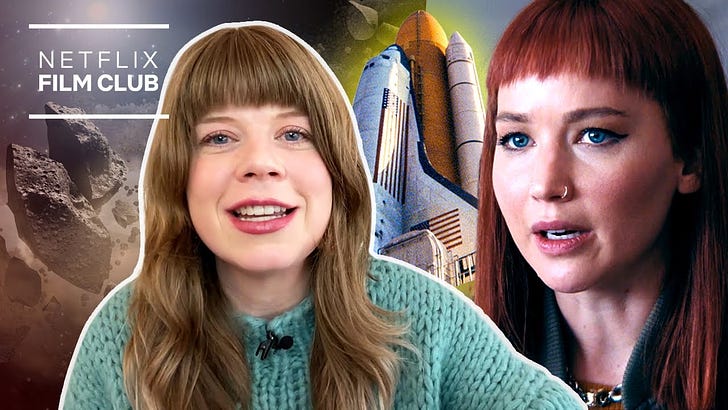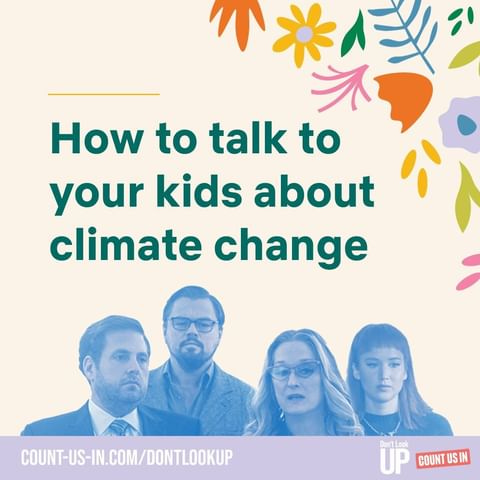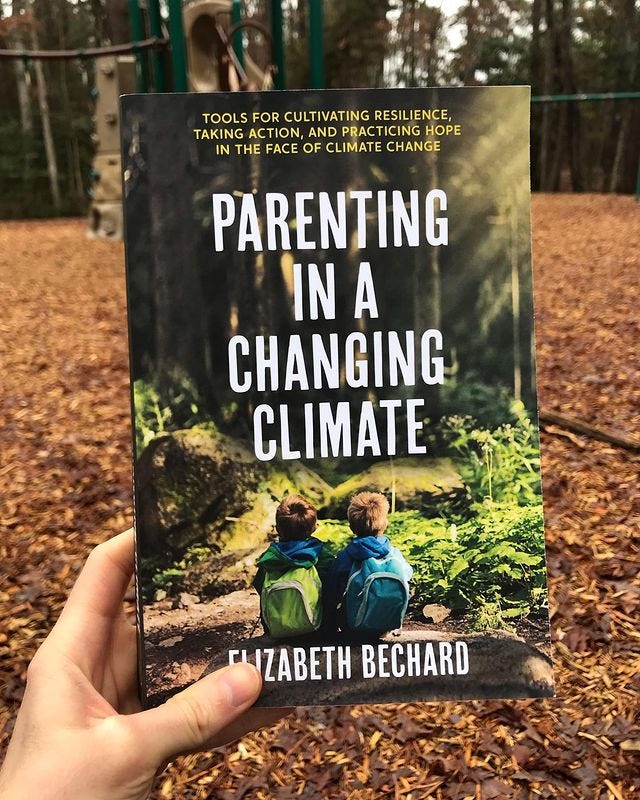Hey and welcome back to Gen Dread!
If you’re new to this corner of the internet, you can subscribe to free emails from me about staying sane in the climate crisis by hitting that nice yellow button right there:
We’ve got two things on deck today:
Adam McKay’s Netflix blockbuster Don’t Look Up (disclaimer: I collaborated with Netflix on some materials around the film’s release but come at this review honestly)
Difficult climate conversations, including resources for parents on how to talk to their kids about the crisis
Let’s get to it!
Don’t Look Up
I was intrigued when Netflix wrote to invite me to film an “experts react” video to a movie that tells the story of a comet coming to destroy earth, that is actually about the climate. Before the film was released and without showing us the whole movie, they played a few clips for myself, an atmospheric scientist, and an expert on conspiracy theories, to get our raw responses. Here’s how that turned out:
(See what they did there? Only just realized the female researcher with bangs trope. Hilarious).
So anyway, that’s how I came to learn of Don’t Look Up, the film that everyone and their grandma has streamed since it was released over the holidays, becoming one of the most watched films on Netflix of all time.
As a climate communicator, I’m fascinated by the polarized reviews it has stirred up. But personally, I loved the movie and the immense validation it brought for so many in the climate movement.
Quick recap in case you haven’t seen the film: the story is a metaphor for the climate crisis, as told through a tale about scientists who’ve discovered a massive comet that is on a collision course with Earth. The comet will arrive in 6 months to obliterate all life on the planet if nothing is done to obstruct its path. We follow their challenges communicating this hard truth to leaders, to the public, as well as how difficult it is to emotionally contain it within themselves. Familiar perversities of private interests, manipulative media, mistrusting publics, conspiracy theories, and psychological defences make for big twists and turns. The ending is not a rosy one of humans pulling together to save the day. McKay’s satire takes the foolishness of our current world and reflects it back, in high definition, in our faces.
McKay took the invitation to create the first climate comedy (something climate communicators have been begging someone to try for a while) and managed to avoid the “hyperobject” of the climate crisis, by not mentioning the climate at all. Philosopher Timothy Morton describes hyperobjects as things that are so overwhelming and all encompassing that we can’t see where they start or stop, and therefore can’t assess where to even engage with them honestly, let alone intervene. By not talking about the climate crisis —- a slow moving disaster unfolding over decades that affects everything from electricity bills to plastic in the oceans to concerns about kids’ futures —- and turning it into a comet crisis instead, McKay side-stepped a well worn psychological pitfall that has long been blamed for why “climate is such a drag to think about”. (He’s also clearly taken with the concept of hyperobjects because founded a production company called Hyperobject Industries).
Unsurprisingly, I loved that Don’t Look Up depicted the psychological toll that existential research findings have on the scientists themselves. In the climate world, this emotional weight extends to activists, green politicians, a wide range of journalists, scholars and creators working on the climate and an increasingly caring general public. Therapists are seeing such psychological responses in their offices more and more. From panic attacks to enragement, to losing the ability to keep one’s cool in media appearances (much like when climate journalist George Monbiot cried on morning TV), the film gave permission to what so many of us are feeling. And it did so while pointing out the largely uncompassionate and studiously psychologically distanced society that surrounds us as we try to do this work.
Some critics saw the film as too blunt, too obvious, and therefore its own kind of disaster. If McKay’s aims were to be subtle, then I’d agree he failed - but clearly that was not his goal and such reviews are missing the point. The point was to show the absurdity of looking away from the obvious existential threat that is hurtling towards us right now, and cause people to face some difficult truths while there’s still time to make decisions about how we’re each going to act. There’s nothing subtle about the task we face. Why should we insist that this film delicately lure us into confronting it with more sophisticated fluency for not rocking people’s psyches?
That said, there’s merit to reviews that pointed out why the satire missed important opportunities (such as what climate analyst Ketan Joshi told the Guardian in terms of what it got wrong about power). Specifically, how it avoided probing the long nefarious relationship the fossil fuel industry has had with our society and political system, by manufacturing doubt about the dangers of fossil fuels and intentionally confusing the public. It would have been great to see these qualities sketched into the the film’s evil corp. And the comet crisis, by nature, hits humanity all at the same time, which is not at all like the climate crisis that hits the most disadvantaged and least responsible for this mess first. However, on both points, I’m not sure McKay could have done it differently considering the form of destruction he chose, which is fast moving and recently discovered, preventing those kinds of histories. All this calls into the question the aptness of a comet as a metaphor for the climate crisis, but I won’t get into all that. Perfection is the enemy IMO.
Some complained about the unhappy ending. This reminds me of what happened back in 2017 when New York Mag published David Wallace-Wells’ seminal Uninhabitable Earth article. That piece left many experts and readers angry about its terrifying tone, arguing that scaring the pants off of people won’t lead them to action. Those who came to Wallace-Wells’ defense said that fear is an important rhetorical tool for probing the kinds of reactions in people that will get them to sit up, reassess the situation and try to change it when they feel their lives are truly threatened. This same debate rears its head all over the climate comms landscape, continues to this day, and is getting old. No one knows the perfect storytelling formula for spurring change. Some react well to fear (in that it moves them to action), others stick their heads in the sand in order to avoid its intolerable accompanying feelings. My take is that it is always a good idea to accompany scary stories with ideas about what can be done to improve things, which fear-inducing climate stories often skip over. It’s also time to go beyond that towards boldly envisioning the future we want instead of plugging leaky holes in a sinking ship. More importantly for our moment though, I think Don’t Look Up, much like The Uninhabitable Earth, is intended to help people cultivate their ‘prospective survivor’ within. And sure, it won’t work for everyone. Some will tune out. This stuff is messy and that’s okay.
McKay was brave in making this film. I’m enthused that he took the risks he did. And even though not everyone agrees, the fact that it has so many people debating how we should be telling climate stories, is a testament to the film’s success.
There is, by the way, an action website that accompanies the Don’t Look Up.
Netflix was also keenly aware that the ending might send some viewers into eco-anxiety spirals. So some climate psych colleagues and I helped them create this “be kind to your mind” step on the Don’t Look Up action site.
How parents can talk to their kids about climate
My colleagues and I also helped Netflix write up some resources for parents on how to talk to their kids about the climate crisis. Check ‘em out in the Instagram post below.
In terms of books to help parents with this task, a great overarching one is the new book by Elizabeth Bechard called Parenting in a Changing Climate.
And here are some more specific ones, divided by age-range:
For parents with children that are twelve or under:
“A Guide for Parents About the Climate Crisis” by the Australian Psychological Society
“How to Talk to Your Kids About Climate Change: Turning Angst into Action” by Harriet Shugarman
“Coco’s Fire: Changing Climate Anxiety Into Climate Action” by Jeremy Wortzel and Lena Champlin
“Your Guide to Talking Kids All Ages About Climate Change” by Natural Resources Defense Council
”All The Feelings Under The Sun” by Leslie Davenport
For parents with teens
Youth generated climate journal by the Climate Journal Project
Youth Leadership and Education Program by the Bioneers
“A Field Guide to Climate Anxiety: How to Keep Your Cool on a Warming Planet” by Sarah Jaquette Ray
For discussions with family members and trusted others
Circles Discussion Groups by All We Can Save
Discussion Groups by Climate Cafes, Climate Psychology Alliance North America, Good Grief Network
“How to Prepare for Climate Change” by David Pogue
“Emotional Inflammation: Discover Your Triggers and Reclaim Your “Equilibrium During Anxious Times” by Lise Van Susteren and Stacey Colino
Climate conversations over the holidays
As mentioned in my last newsletter, I’m hoping to collect YOUR STORIES of climate conversations you’ve had, maybe over the recent holidays (though any memorable ones will do), that meant you had to go outside of your comfort zone. These conversations can be fraught with disagreement and difficult emotions, causing people to avoid them all together. But we all need to get better at having these kinds of hard conversations in ways that are productive for the climate and ourselves. If I am able to collect a nice smattering of stories from readers, I’ll invite a climate conversations expert to pore through them and suggest how they can be approached with more effectiveness for shared understanding and connection building next time (to be published in a future newsletter). So please, unload your stories in the comments section, or respond to this email, and we’ll make it happen.
Climate emotions podcast
Finally, if you haven’t already, please fill out very short survey about what kind of climate emotions podcasts you’d like to see in the world. Big thanks from the Climate Mental Health Network and Gen Dread. We’ll get this information into the hands of creators.
That’s all for this edition
As always, you can reach me - and each other - by commenting on this article. You can also reach me by hitting reply to this email or following me on Twitter and Instagram.
Sending joy!
Britt







Excellent thoughts in your review of Don't Look Up. Now to deepen the matter a bit, I'm an ecological designer, which colours my attitudes to the climate predicament. Specifically, I consider the processes of human induced climate change to be a secondary effect of the larger reality of the human species over-consumption of the energy and material processes of the planet. The tendency for high trophic order species to have such impacts on their environment is widely known in ecological circles. We are not an exceptional species with respect to ecological processes. We are simply able to be far more global and multilayered in our effects due to various cultural and technological "advances". In the end, high trophic order species exhibit boom and bust cycles, extinction, or develop behavioural adaptations that serve to limit populations and consumptive effects (for example, territoriality or mating constraints). I am "optimistic" that we can come to see the necessity and eventual benefits of consciously evolving into symbiont species rather than continuing our dominant collective behaviour, which can only be labelled as a predatory parasites. Another thought- species evolve at the uncomfortable edges of their current habitat. Look to the adaptive responses of some less advantaged regions, rather than expecting the effective adaptation to arise in the comfortable privileged areas of Europe, most of N America and industrialized Asia. I am inspired by Cuba, Kerala, Rwanda, Iceland, the Faroe Islands and some remote regions of Scandinavia and Canada.
To the question in the headline — "is Don't Look Up the first climate psych film?" — I think that title still has to go to "First Reformed", even if "First Reformed" was much smaller in terms of buzz. However, whereas "First Reformed" focused more strictly on climate anxiety and despair, I think "Don't Look Up" is the first climate-*activism* psych film.
What is special and unique about the psychology portrayed in "Don't Look Up" is that it shows how our current media environment (driven by celebrity, sensation, and comfort) and political system can mess with the minds of even the most well-intended climate activists. I say this as someone who felt the need to step back from the frontlines of the climate movement after appearing in a climate documentary! I certainly saw elements of myself in both Leonardo DiCaprio's character and Jennifer Lawrence's character.